Page 33 of 117
STARTING AND OPERATING
CONTENTS
�STARTING PROCEDURES .................33
▫ Automatic Transmission .................34
▫ Extreme Cold Weather ...................34
▫ Normal Starting Procedure —
Keyless Enter-N-Go .....................35
▫ Starting Fluids ........................36
� NORMAL OPERATION ...................36
▫ Cold Weather Precautions ................37
▫ Engine Idling .........................39
▫ Stopping The Engine ....................39 ▫
Cooling System Tips — Automatic
Transmission ..........................40
� ENGINE BLOCK HEATER — IF EQUIPPED ....41
� FUEL REQUIREMENTS ...................42
▫ Fuel Specifications .....................43
▫ Biodiesel Fuel Requirements ...............44
� TRAILER TOWING ......................47
▫ Common Towing Definitions ..............47
▫ Trailer Hitch Classification ...............514
Page 62 of 117
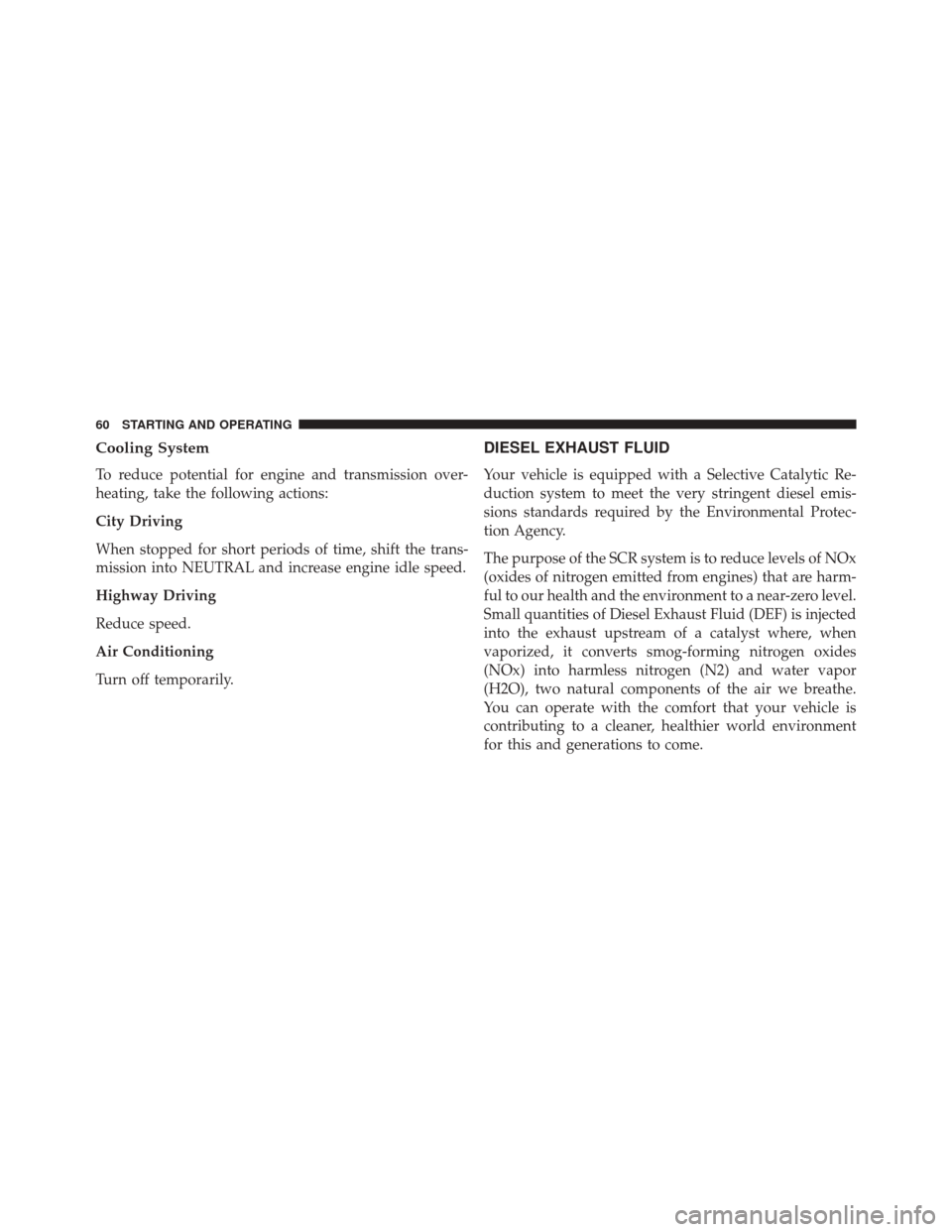
Cooling System
To reduce potential for engine and transmission over-
heating, take the following actions:
City Driving
When stopped for short periods of time, shift the trans-
mission into NEUTRAL and increase engine idle speed.
Highway Driving
Reduce speed.
Air Conditioning
Turn off temporarily.
DIESEL EXHAUST FLUID
Your vehicle is equipped with a Selective Catalytic Re-
duction system to meet the very stringent diesel emis-
sions standards required by the Environmental Protec-
tion Agency.
The purpose of the SCR system is to reduce levels of NOx
(oxides of nitrogen emitted from engines) that are harm-
ful to our health and the environment to a near-zero level.
Small quantities of Diesel Exhaust Fluid (DEF) is injected
into the exhaust upstream of a catalyst where, when
vaporized, it converts smog-forming nitrogen oxides
(NOx) into harmless nitrogen (N2) and water vapor
(H2O), two natural components of the air we breathe.
You can operate with the comfort that your vehicle is
contributing to a cleaner, healthier world environment
for this and generations to come.
60 STARTING AND OPERATING
Page 73 of 117
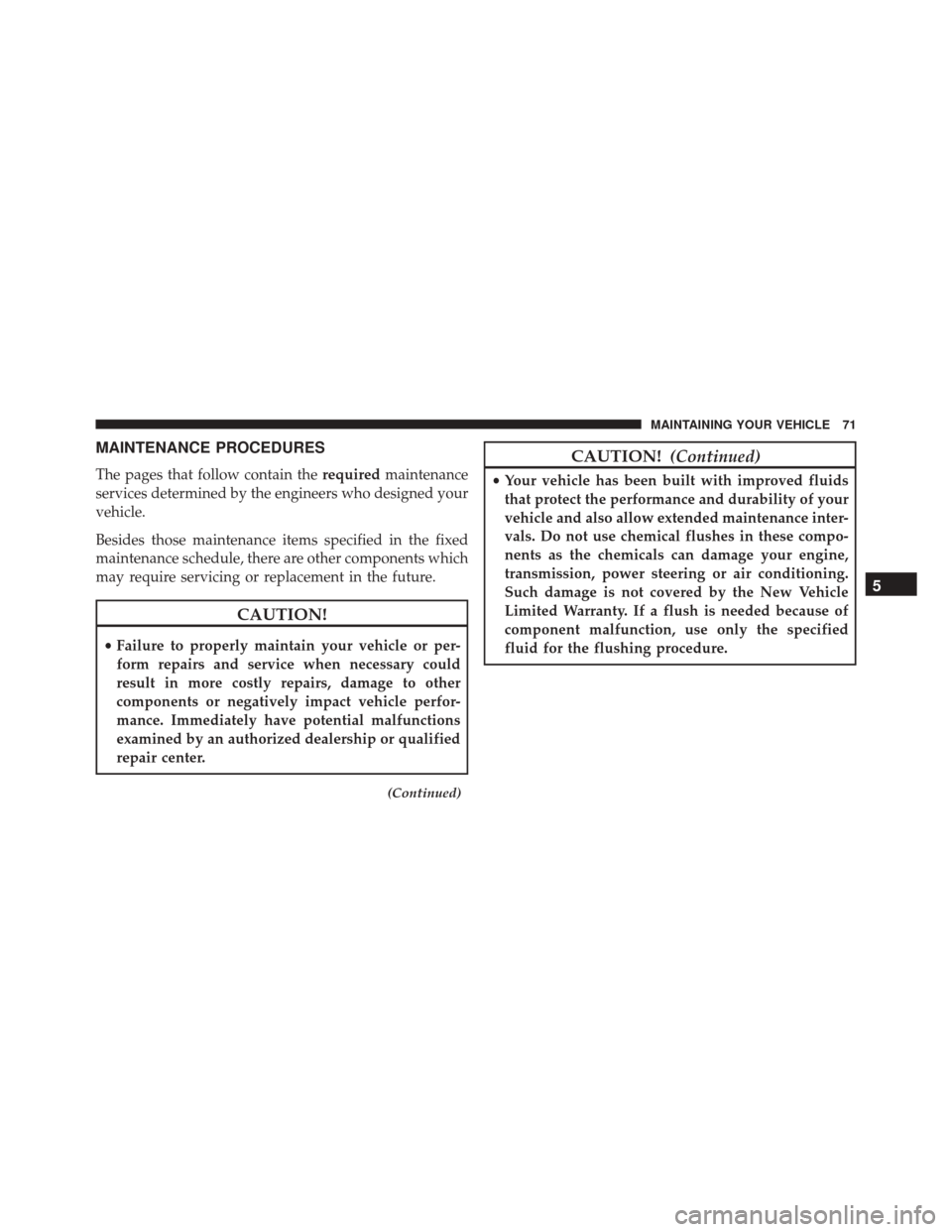
MAINTENANCE PROCEDURES
The pages that follow contain therequiredmaintenance
services determined by the engineers who designed your
vehicle.
Besides those maintenance items specified in the fixed
maintenance schedule, there are other components which
may require servicing or replacement in the future.
CAUTION!
• Failure to properly maintain your vehicle or per-
form repairs and service when necessary could
result in more costly repairs, damage to other
components or negatively impact vehicle perfor-
mance. Immediately have potential malfunctions
examined by an authorized dealership or qualified
repair center.
(Continued)
CAUTION! (Continued)
•Your vehicle has been built with improved fluids
that protect the performance and durability of your
vehicle and also allow extended maintenance inter-
vals. Do not use chemical flushes in these compo-
nents as the chemicals can damage your engine,
transmission, power steering or air conditioning.
Such damage is not covered by the New Vehicle
Limited Warranty. If a flush is needed because of
component malfunction, use only the specified
fluid for the flushing procedure.
5
MAINTAINING YOUR VEHICLE 71
Page 97 of 117
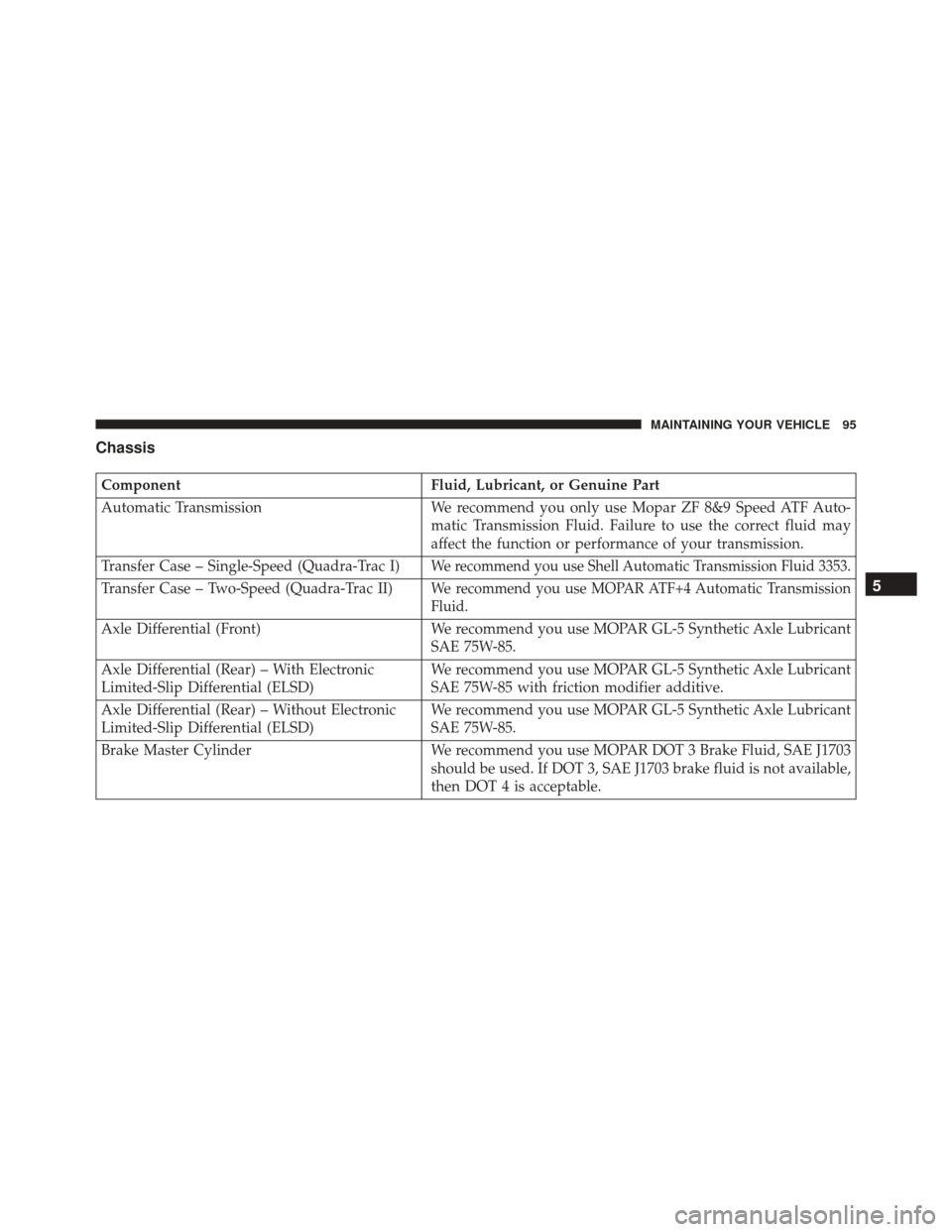
Chassis
ComponentFluid, Lubricant, or Genuine Part
Automatic Transmission We recommend you only use Mopar ZF 8&9 Speed ATF Auto-
matic Transmission Fluid. Failure to use the correct fluid may
affect the function or performance of your transmission.
Transfer Case – Single-Speed (Quadra-Trac I)
We recommend you use Shell Automatic Transmission Fluid 3353.
Transfer Case – Two-Speed (Quadra-Trac II)We recommend you use MOPAR ATF+4 Automatic Transmission
Fluid.
Axle Differential (Front) We recommend you use MOPAR GL-5 Synthetic Axle Lubricant
SAE 75W-85.
Axle Differential (Rear) – With Electronic
Limited-Slip Differential (ELSD) We recommend you use MOPAR GL-5 Synthetic Axle Lubricant
SAE 75W-85 with friction modifier additive.
Axle Differential (Rear) – Without Electronic
Limited-Slip Differential (ELSD) We recommend you use MOPAR GL-5 Synthetic Axle Lubricant
SAE 75W-85.
Brake Master Cylinder We recommend you use MOPAR DOT 3 Brake Fluid, SAE J1703
should be used. If DOT 3, SAE J1703 brake fluid is not available,
then DOT 4 is acceptable.
5
MAINTAINING YOUR VEHICLE 95
Page 101 of 117
Engine Oil Filter Replacement
Residual oil in the housing may spill from the housing
when the new filter is installed if the residual oil is not
either removed from the housing or enough time has not
elapsed to allow the oil to drain back into the engine.
When servicing the oil filter on this engine, carefully
remove the filter and use a suction gun to remove any
residual oil left in the housing or wait about 30 minutes
for the oil to drain back into the engine.Once A Month Or Before A Long Trip:
•
Check engine oil level
• Check windshield washer fluid level
• Check the tire inflation pressures and look for unusual
wear or damage
• Check the fluid levels of the coolant reservoir, brake
master cylinder, power steering and transmission as
needed
• Check function of all interior and exterior lights
6
MAINTENANCE SCHEDULE 99
Page 102 of 117
Required Maintenance
Refer to the Maintenance Schedules on the following
pages for required maintenance.
At Every Oil Change Interval As Indicated By Oil Change Indicator System:
•Change oil and filter.
• Completely fill the Diesel Exhaust Fluid tank.
• Drain water from fuel filter assembly.
• Rotate the tires. Rotate at the first sign of irregular wear, even if it occurs before the oil indicator system
turns on.
• Inspect battery and clean and tighten terminals as required.
• Inspect automatic transmission fluid if equipped with dipstick.
• Inspect brake pads, shoes, rotors, drums, hoses and park brake.
• Inspect engine cooling system protection and hoses.
• Inspect exhaust system.
• Inspect engine air cleaner if using in dusty or off-road conditions.
100 MAINTENANCE SCHEDULE
Page 110 of 117
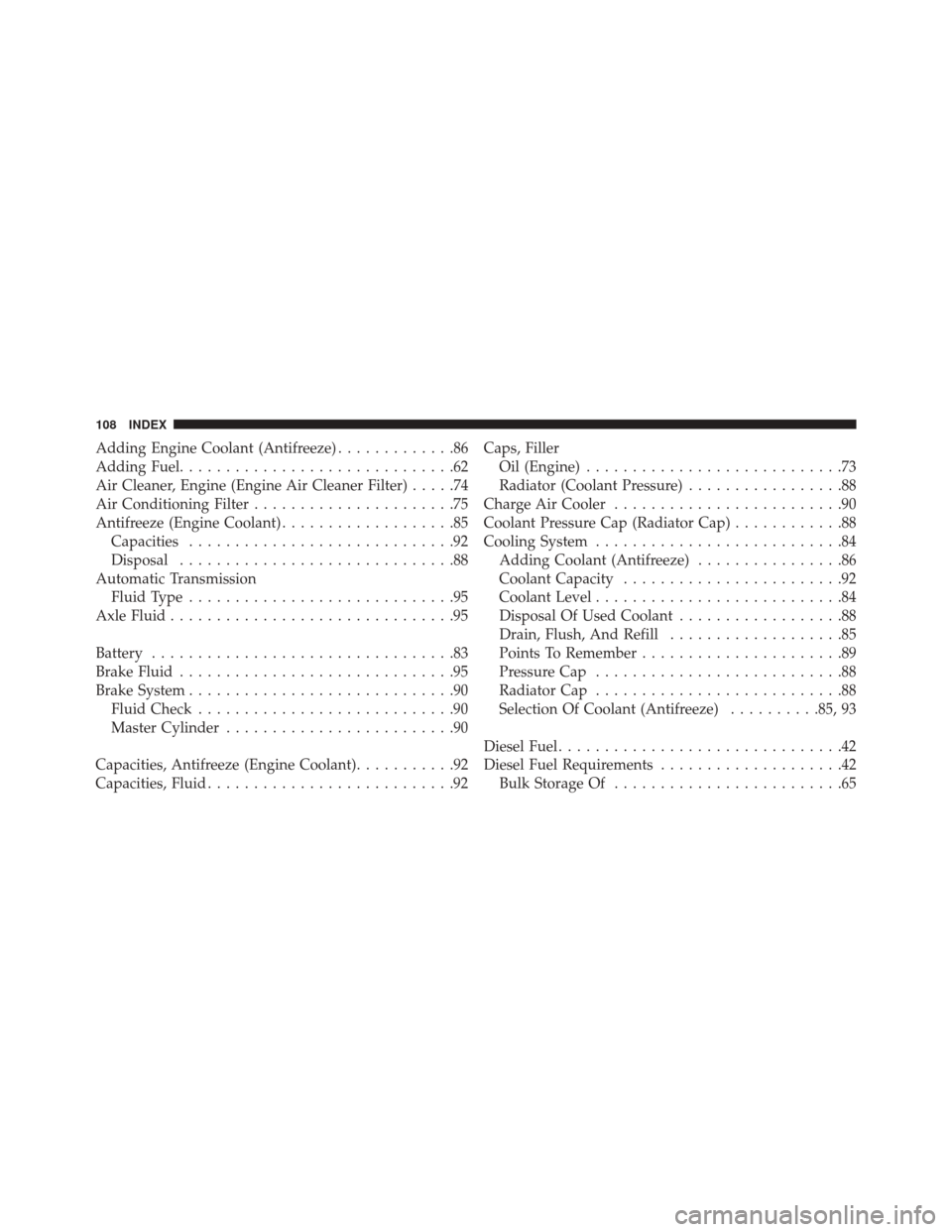
Adding Engine Coolant (Antifreeze).............86
Adding Fuel ..............................62
Air Cleaner, Engine (Engine Air Cleaner Filter) .....74
Air Conditioning Filter ......................75
Antifreeze (Engine Coolant) ...................85
Capacities .............................92
Disposal ..............................88
Automatic Transmission Fluid Type .............................95
Axle Fluid ...............................95
Battery .................................83
Brake Fluid ..............................95
Brake System .............................90
Fluid Check ............................90
Master Cylinder .........................90
Capacities, Antifreeze (Engine Coolant) ...........92
Capacities, Fluid ...........................92 Caps, Filler
Oil (Engine) ............................73
Radiator (Coolant Pressure) .................88
Charge Air Cooler .........................90
Coolant Pressure Cap (Radiator Cap) ............88
Cooling System ...........................84
Adding Coolant (Antifreeze) ................86
Coolant Capacity ........................92
Coolant Level ...........................84
Disposal Of Used Coolant ..................88
Drain, Flush, And Refill ...................85
Points To Remember ......................89
Pressure Cap ...........................88
Radiator Cap ...........................88
Selection Of Coolant (Antifreeze) ..........85, 93
Diesel Fuel ...............................42
Diesel Fuel Requirements ....................42
Bulk Storage Of .........................65
108 INDEX
Page 112 of 117
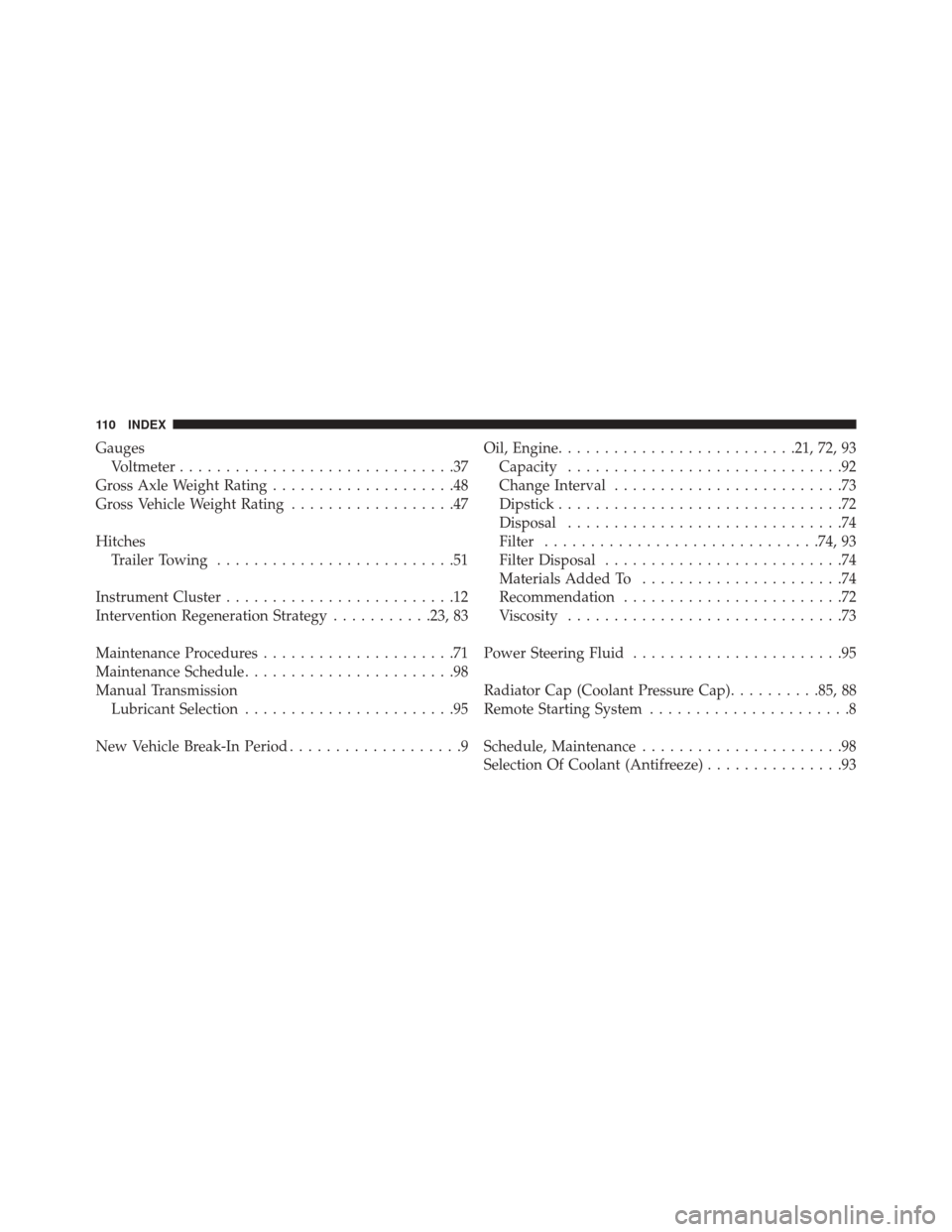
GaugesVoltmeter ..............................37
Gross Axle Weight Rating ....................48
Gross Vehicle Weight Rating ..................47
Hitches Trailer Towing ..........................51
Instrument Cluster .........................12
Intervention Regeneration Strategy ...........23, 83
Maintenance Procedures .....................71
Maintenance Schedule .......................98
Manual Transmission Lubricant Selection .......................95
New Vehicle Break-In Period ...................9 Oil, Engine
......................... .21, 72, 93
Capacity ..............................92
Change Interval .........................73
Dipstick ...............................72
Disposal ..............................74
Filter ............................. .74, 93
Filter Disposal ..........................74
Materials Added To ......................74
Recommendation ........................72
Viscosity ..............................73
Power Steering Fluid .......................95
Radiator Cap (Coolant Pressure Cap) ..........85, 88
Remote Starting System ......................8
Schedule, Maintenance ......................98
Selection Of Coolant (Antifreeze) ...............93
110 INDEX